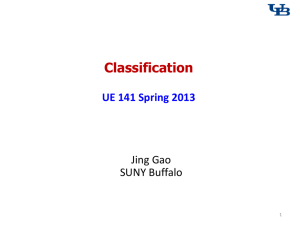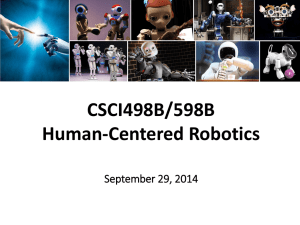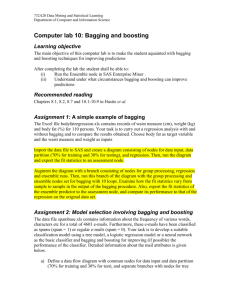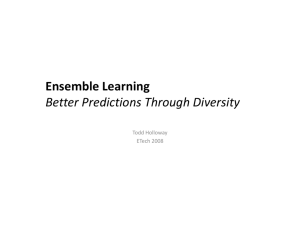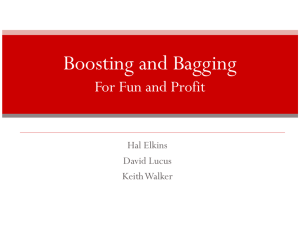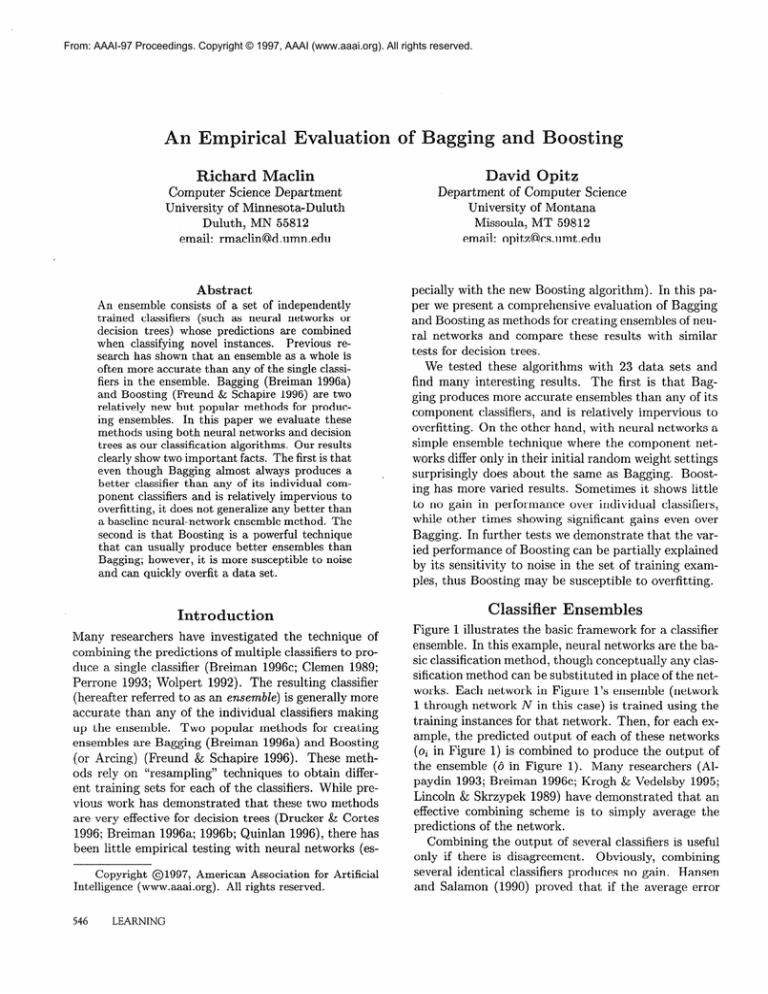
From: AAAI-97 Proceedings. Copyright © 1997, AAAI (www.aaai.org). All rights reserved.
irical Evaluation
ad
Richard Maclin
David Opitz
Department of Computer Science
University of Montana
Missoula, MT 59812
email: opitz@cs.umt.edu
Introduction
Many researchers have investigated the technique of
combining the predictions of multiple classifiers to produce a single classifier (Breiman 1996c; Clemen 1989;
Perrone 1993; Wolpert 1992). The resulting classifier
(hereafter referred to as an ensemble) is generally more
accurate than any of the individual classifiers making
up the ensemble. Two popular methods for creating
ensembles are Bagging (Breiman 1996a) and Boosting
(or Arcing) (Freund & Schapire 1996). These methods rely on “resampling” techniques to obtain different training sets for each of the classifiers. While previous work has demonstrated that these two methods
are very effective for decision trees (Drucker & Cortes
1996; Breiman 1996a; 1996b; Quinlan 1996), there has
been little empirical testing with neural networks (esCopyright 01997, American Association for Artificial
Intelligence (www.aaai.org). All rights reserved.
LEARNING
agging
Computer Science Department
University of Minnesota-Duluth
Duluth, MN 55812
email: rmaclin@d.umn.edu
Abstract
An ensemble consists of a set of independently
trained classifiers (such as neural networks or
decision trees) whose predictions are combined
when classifying novel instances. Previous research has shown that an ensemble as a whole is
often more accurate than any of the single classifiers in the ensemble. Bagging (Breiman 1996a)
and Boosting (F’reund & Schapire 1996) are two
relatively new but popular methods for producing ensembles. In this paper we evaluate these
methods using both neural networks and decision
trees as our classification algorithms. Our results
clearly show two important facts. The first is that
even though Bagging almost always produces a
better classifier than any of its individual component classifiers and is relatively impervious to
overfitting, it does not generalize any better than
a baseline neural-network ensemble method. The
second is that Boosting is a powerful technique
that can usually produce better ensembles than
Bagging; however, it is more susceptible to noise
and can quickly overfit a data set.
546
of
pecially with the new Boosting algorithm). In this paper we present a comprehensive evaluation of Bagging
and Boosting as methods for creating ensembles of neural networks and compare these results with similar
tests for decision trees.
We tested these algorithms with 23 data sets and
find many interesting results. The first is that Bagging produces more accurate ensembles than any of its
component classifiers, and is relatively impervious to
overfitting. On the other hand, with neural networks a
simple ensemble technique where the component networks differ only in their initial random weight settings
surprisingly does about the same as Bagging. Boosting has more varied results. Sometimes it shows little
to no gain in performance over individual classifiers,
while other times showing significant gains even over
Bagging. In further tests we demonstrate that the varied performance of Boosting can be partially explained
by its sensitivity to noise in the set of training examples, thus Boosting may be susceptible to overfitting.
Classifier Ensembles
Figure 1 illustrates the basic framework for a classifier
ensemble. In this example, neural networks are the basic classification method, though conceptually any classification method can be substituted in place of the networks. Each network in Figure l’s ensemble (network
1 through network N in this case) is trained using the
training instances for that network. Then, for each example, the predicted output of each of these networks
(oi in Figure 1) is combined to produce the output of
the ensemble (6 in Figure 1). Many researchers (Alpaydin 1993; Breiman 1996c; Krogh & Vedelsby 1995;
Lincoln & Skrzypek 1989) have demonstrated that an
effective combining scheme is to simply average the
predictions of the network.
Combining the output of several classifiers is useful
only if there is disagreement. Obviously, combining
several identical classifiers produces no gain. Hansen
and Salamon (1990) proved that if the average error
^o
QQ ensemble output
fr
@0 8 input
Figure 1: A classifier ensemble of neural networks.
rate for an example is less than 50% and the component classifiers in the ensemble are independent in
the production of their errors, the expected error for
that example can be reduced to zero as the number of
classifiers combined goes to infinity; however, such assumptions rarely hold in practice. Krogh and Vedelsby
(1995) later proved that the ensemble error can be divided into a term measuring the average generalization
error of each individual classifier and a term measuring the disagreement among the classifiers. What they
formally showed was that an ideal ensemble consists
of highly correct classifiers that disagree as much as
possible. Opitz and Shavlik (1996a,1996b) empirically
verified that such ensembles generalize well.
As a result, methods for creating ensembles center
around producing classifiers that disagree on their predictions. Generally, these methods focus on altering
the training process in the hope that the resulting classifiers will produce different predictions. For example,
neural network techniques that have been employed
include methods for training with different topologies, different initial weights, different parameters, and
training only on a portion of the training set (Alpaydin 1993; Drucker et al. 1994; Hansen & Salamon 1990;
Maclin & Shavlik 1995). In this paper we concentrate
on two popular methods (Bagging and Boosting) that
try to generate disagreement among the classifiers by
altering the training set each classifier sees.
Bagging
Classifiers
Bagging (Breiman 1996a) is a “bootstrap” (Efron &
Tibshirani 1993) ensemble method that creates individuals for its ensemble by training each classifier on
a random redistribution of the training set, Each classifier’s training set is generated by randomly drawing,
with replacement, N examples - where N is the size
of the original training set; many of the original examples may be repeated in the resulting training set
while others may be left out. Each individual classifier
in the ensemble is generated with a different random
sampling of the training set.
Boosting
Classifiers
Boosting (Freund & Schapire 1996) encompasses a
family of methods. The focus of these methods is to
produce a series of classifiers. The training set used
for each member of the series is chosen based on the
performance of the earlier classifier(s) in the series. In
Boosting, examples that are incorrectly predicted by
previous classifiers in the series are chosen more often than examples that were correctly predicted. Thus
Boosting attempts to produce new classifiers for its
ensemble that are better able to correctly predict examples for which the current ensemble performance is
poor. (Note that in Bagging, the resampling of the
training set is not dependent on the performance of
the earlier classifiers.)
In this work we examine two new and powerful
forms of Boosting: Arcing (Breiman 199613) and AdaBoosting (Freund & Schapire 1996).
Like Bagging,
these methods choose a training set of size N for classifier K + 1 by probabilistically selecting (with replacement) examples from the original N training examples.
Unlike Bagging, however, the probability of selecting
an example is not equal across the training set. This
probability depends on how often that example was
misclassified by the previous K classifiers.
Both methods initially set the probability of picking
each example to be l/N. These methods then recalculate these probabilities after each trained classifier is
added to the ensemble. For Ada-Boosting, let ok be the
sum of the misclassified instance probabilities of the
currently trained classifier C,Q. The probabilities for
the next trial are generated by multiplying the probabilities of Ck’s incorrectly classified instances by the
factor ,& = (1 - Q)/Q and then renormalizing these
probabilities so that their sum equals 1. Ada-Boosting
combines the classifiers Ci 7. . . 7Ck using weighted voting where CI, has weight log(&). We use the revision
described by Breiman (1996b) where we reset all the
weights to be equal and restart if either Ek is not less
than 0.5 or Ek becomes 0.
Arcing updates these probabilities somewhat differently. For the ith example in the training set, the value
rni refers to the number of times that example was misclassified by the previous K classifiers. The probability
pi for selecting example i to be part of classifier K + l’s
training set is defined as
Pi
=
1+mi4
C;“=I C1 + “j4)
(1)
Breiman chose the value of the power (4) empirically
after trying several different values (Breiman 199613).
Unlike Ada-Boosting, Arcing combines its classifiers by
unweighted voting.
MODEL SELECTION & OVERFITTING
547
Table 1: Summary of the data sets used in this paper. Shown are the number of examples in the data set; the
number of output classes; the number of continuous and discrete features describing the examples; the number of
input, output, and hidden units used in the networks; and how many epochs each network was trained.
Dataset
Cases
Classes
breast-cancer-w
credit-a
credit-g
diabetes
glass
heart-Cleveland
hepatitis
house-votes-84
699
690
1000
768
214
303
155
435
3772
351
159
3196
57
20000
936
1877
6435
2310
3772
208
683
3190
846
2
2
2
2
6
2
2
2
5
2
3
2
2
26
2
2
6
7
2
2
19
3
4
hYP0
ionosphere
iris
kr-vs-kp
labor
letter
promoters-936
ribosome-bind
satellite
segmentation
sick
sonar
soybean
splice
vehicle
Features
Continuous
Discrete
9
6
7
9
9
8
6
7
34
4
8
16
9
13
5
13
16
22
36
8
57
49
36
19
7
60
22
35
60
18
Results
To evaluate the performance of Bagging and Boosting we performed experiments on a number of data
sets drawn from the UC1 data set repository (Murphy
& Aha 1994). We report Bagging and Boosting error
rates for each data set for both neural network and
decision tree ensembles along with the error rate for
simply using a single network or single decision tree.
We also report results for a very simple.network ensemble approach - creating an ensemble of networks where
each network varies only by randomly initializing the
weights of the network.
Inputs
9
47
63
8
9
13
32
16
55
34
4
74
29
16
228
196
36
19
55
60
134
240
18
Neural Network
outputs
Hiddens
1
5
1
10
1
10
1
5
6
10
1
5
1
10
1
5
5
15
1
10
3
5
1
15
1
10
26
40
1
20
1
20
6
15
7
15
1
10
1
10
19
25
2
25
4
10
Epochs
20
35
30
30
80
40
60
40
40
40
80
20
80
30
30
35
30
20
40
60
40
30
40
and weights are initialized randomly to be between -0.5
and 0.5. The number of hidden units and epochs used
for training are given in the next section. We chose
the number of hidden units based on the number of
input and output units. This choice was based on the
criteria of having at least one hidden unit per output,
at least one hidden unit for every ten inputs, and five
hidden units being a minimum. The number of epochs
was based both on the number of examples and the
number of parameters (i.e., topology) of the network.
For the decision trees we used the C4.5 tool (Quinlan 1996) using pruned trees as suggested in Quinlan’s
work (which empirically produce better performance).
Methodology
Datasets
All results are averaged over five standard PO-fold
cross validation experiments. For each lo-fold cross
validation the data set is first partitioned into 10 equalsized sets, then each set is in turn used as the test set
while the classifier trains on the other nine sets. For
each fold an ensemble of 10 networks is created (for
a total of 100 networks for each lo-fold cross validation). Parameter settings for the neural networks include a learning rate of 0.15, a momentum term of 0.9,
Our data sets were drawn from the UC1 repository with
emphasis on ones that were previously investigated by
other researchers. Table 1 gives the characteristics of
the data sets we chose. The data sets chosen vary
across a number of dimensions including: the type of
the features in the data set (i.e., continuous discrete,
or a mix of the two); the number of output classes; and
the number of examples in the data set. Table 1 also
shows the architecture and training parameters used
548
LEARNING
Table 2: Test set error rates for the data sets using (1) a single neural network classifier; (2) an ensemble where
each individual network is trained using the original training set and thus only differs from the other networks
in the ensemble by its random initial weights; (3) an ensemble where the networks are trained using randomly
resampled training sets (Bagging); an ensemble where the networks are trained using weighted resampled training
sets (Boosting) where the resampling is based on the (4) A rcing method and (5) Ada method; (6) a single decision
tree classifier; (7) a Bagging ensemble of decision trees; and (8) a Boosting ensemble of decision trees.
Neural Network
Dataset
breast-cancer-w
credit-a
credit-g
diabetes
glass
heart-Cleveland
hepatitis
house-votes-84
hYP0
ionosphere
iris
kr-vs- kp
labor
letter
promoters-936
ribosome-bind
satellite
segmentation
sick
sonar
soybean
splice
vehicle
Standard
3.3
14.8
28.3
23.6
38.5
18.2
19.9
5.0
6.4
10.1
4.3
2.3
5.3
18.0
5.0
9.5
12.9
6.7
6.0
16.9
9.0
4.7
24.5
Simple
3.4
14.0
24.4
22.8
35.5
17.3
19.6
4.9
6.2
8.0
4.0
0.9
4.2
12.8
4.8
8.5
11.1
5.6
5.7
16.7
6.4
4.0
21.1
Bagging
3.3
14.1.
24.3
23.2
33.7
16.7
18.1
4.3
6.2
7.6
4.3
0.9
4.9
12.5
4.5
8.4
11.0
5.3
5.8
16.5
6.8
3.9
21.7
in our neural networks experiments.
Experimental Results
Table 2 shows the neural network and decision tree
error rates for the data sets described in Table 1 for
the five neural network methods and three decision tree
methods discussed in this paper.
Discussion
One conclusion that can be drawn from the results
is that both the Simple Ensemble and Bagging approaches almost always produces better performance
than just training a single classifier. For some of these
data sets (e.g., glass, kr-vs-kp, letter, segmentation,
soybean, and vehicle) the gains in performance are
quite significant. One aspect many of these data sets
share is that they involve predictions for more than
two classes, which suggests that ensembles may be especially important for this type of data. Another interesting conclusion is that Bagging produces results sim-
64.5
Boosting
Arcing
Ada
3.2
3.9
14.8
16.2
24.8
26.4
23.6
22.8
31.5
33.2
18.9
19.1
18.9
18.1
4.7
5.1
6.4
6.2
7.0
8.0
2.9
3.3
0.6
0.4
3.2
5.0
6.2
4.6
4.7
4.7
8.4
8.5
10.3
10.3
3.7
3.7
5.4
4.8
15.9
12.5
6.5
6.3
4.0
4.3
19.3
19.5
Standard
5.0
14.9
29.6
28.3
30.9
24.3
21.6
3.5
0.5
8.1
6.0
0.6
15.1
14.0
12.8
11.2
13.8
3.7
1.3
29.0
8.0
5.9
29.4
Bagging
3.3
12.1
22.8
21.9
28.4
18.1
16.5
3.6
0.4
6.0
4.6
0.5
13.3
10.6
9.5
9.3
10.8
2.8
1.0
21.6
8.0
5.7
26.1
Boosting
Ada
3.1
12.6
22.9
22.3
30.5
17.4
13.8
4.4
0.4
6.0
5.6
0.3
13.2
6.7
6.3
9.1
10.4
2.3
0.9
19.7
7.9
6.3
24.8
ilar to those of the Simple Ensemble. What this shows
is that simply changing the initial weight settings of
a neural network is nearly as effective at causing necessary changes in a network’s predictions as creating
small changes in the training set.
For Boosting, the results are more varied. Arcing
sometimes produces results that are the same or worse
than using a single classifier; however, other times it
not only significantly outperforms using a single classifier, but significantly outperforms Bagging (e.g., kr-vskp, letter, segmentation, and vehicle). Ada-Boosting’s
results are even more extreme. For certain data sets
(kr-vs-kp, letter, sonar), Ada-Boosting produces a significant gain over any other method (including Arcing).
On other data sets Ada-Boosting produces results that
are even worse than using a single classifier (breastcancer-Wisconsin, credit-a, heart-Cleveland). For both
Boosting methods, it seems that when they work, they
are extremely effective; on the other hand, when the
MODEL SELECTION & OVERFITTING
549
diabetes
4-
9
GE_
_ _ -A. _ _ _ _ _A _ _
0
5
10 15 20
25
Noise rate (%)
Random
-
h
- -O-
-
Bagging
Boosting (Arcing)
-
v-
- --
-
Boosting (Ada)
30
Noise rate (%)
Noise rate (%)
Figure 2: Simple, Bagging, and Boosting (Arcing and Ada) neural network ensembles reduction in error rate
compared to using a single neural network classifier on four data sets with varying levels of noise introduced into
the data set. Graphed is the percentage point reduction in error (e.g., for 5% noise in the segmentation data set,
if the single network method had an error rate of 15.9% and the Bagging method had an error rate of 14.7%, then
this is graphed as a 1.2 percentage point reduction in the error rate).
Boosting methods fail they can often hinder performance. It is also interesting to note that both Boosting methods significantly outperform Bagging on the
letter, segmentation, and vehicle domains, which suggests that their positive effects may be greatest when
multiple classes are predicted.
Freund & Shapire (1996) suggested that the sometimes poor performance of Boosting results from overfitting the training set since later training sets may be
over-emphasizing examples that are noise (thus creating extremely poor classifiers). This argument seems
especially pertinent to Ada-Boosting for two reasons.
The first and most obvious reason is that its method
for updating the probabilities may be over-emphasizing
noisy examples. The second reason is that the classifiers are combined using weighted voting. Previous
work (Sollich & Krogh 1996) has shown that optimizing the combining weights can lead to overfitting while
an unweighted voting scheme is generally resilient to
the problems of overfitting.
To evaluate the hypothesis that Boosting may be
prone to overfitting we performed a second set of experiments using the four ensemble neural network methods. We introduced 5%, lo%, 20%, and 30% noise2
into four different data sets. At each level we created
five different noisy data sets, performed a lo-fold cross
validation on each, then averaged over the five results.
In Figure 2 we show the reduction in error rate for each
of the ensemble methods compared to using a single
neural network classifier. These results demonstrate
that as the noise level grows, the efficacy of the Simple and Bagging ensembles generally increases while
25% noise indicates that 5% of the features of the example, both input and output features, were randomly
changed to other feature values.
550
LEARNING
the Arcing and Ada-Boosting ensembles gains in performance are much smaller (or may actually decrease).
Note that this effect is more extreme for Ada-Boosting
which supports our hypothesis that Ada-Boosting is
more effected by noise. This suggests that Boosting’s poor performance for certain data sets may be
explained by overfitting noise in those data sets.
Finally, we can compare the results of the neural network approaches with the C4.5 approaches. Here the
results are nearly equivocal. Neural networks perform
significantly better than decision trees for several data
sets but decision trees also outperform neural networks
for several data sets, so no strong conclusions can be
drawn. One interesting thing to note is that the performance of Bagging and Boosting on neural networks
generally correlates with the performance of Bagging
and Boosting on C4.5. This suggests that the advantages and disadvantages of both Bagging and Boosting
are independent of the classifier used and depend only
on the domain on which they are being applied.
Future
Work
Though our results do indeed suggest that both Boosting methods are prone to overfitting, we noted that
there are at least two possible explanations for this:
(1) over-emphasizing noisy examples in the later training sets; and (2) weighted voting of the networks. We
plan to perform further experiments to determine if
the overfitting that occurs is explained by one of these
factors or by a combination of both.
Since the Boosting methods are extremely successful in many domains, we plan to investigate novel approaches that will retain the benefits of Boosting. The
goal will be to create a learner where you can essentially push a start button and let it run. To do this
we would try to preserve the benefits of Boosting while
preventing overfitting on noisy data sets.
We also plan to compare Bagging and Boosting
methods to other methods introduced more recently.
In particular we intend to examine the use of Stacking
(Wolpert 1992) as a method of training a combining
function, so as to avoid the effect of having to weight
classifiers. We will also compare Bagging and Boosting
to other methods such as Opitz and Shavlik’s (1996b)
approach to creating an ensemble. This approach uses
genetic search to find classifiers that are accurate and
differ in their predictions.
This paper presents an empirical evaluation of Bagging
(Breiman 1996a) and Boosting (Freund & Schapire
1996) for neural networks and decision trees. Our results demonstrate that a Bagging ensemble nearly always outperforms a single classifier. Our results also
show that an Arcing ensemble can greatly outperform
both a Bagging ensemble and a single classifier. However, for some data sets Arcing only shows a small or
zero gain in performance over a single classifier. Similarly, we show that an Ada-Boosting ensemble can
outperform all of the other methods (including Arcing), but that Ada-Boosting can also actually produce
worse performance than using a single classifier. Further tests demonstrate that the performance of both
methods of Boosting declines as the amount of noise
in a data set increases, and that this result is more
extreme in Ada-Boosting.
In conclusion, as a general
technique, Bagging is probably appropriate for most
problems, but when properly applied, Boosting (either
Arcing or Ada) may produce larger gains in accuracy.
Acknowledgements
This research was partially supported by University of
Minnesota Grants-in-Aid to both authors. We wish
to thank Mike Henderson for his work on the Bagging
and Boosting versions of C4.5. David Opitz completed
a portion of this work while at the University of Minnesota, Duluth.
References
Alpaydin, E. 1993. Multiple networks for function learning. In Proceedings of the 1993 IEEE International
Conference on Neural Networks, volume I, 27-32.
Learning
24(2):123-140.
Breiman, L. 1996b. Bias, variance, and arcing classifiers.
Technical Report TR 460, UC-Berkeley, Berkeley, CA.
Breiman, L. 1996c. Stacked regressions. Machine
Drucker, H.; Cortes, C.; Jackel, L.; LeCun, Y.; and Vapnik, V. 1994. Boosting and other machine learning algorithms. In Proceedings of the Eleventh International
Conference on Machine Learning, 53-61. New Brunswick, NJ:
Morgan Kaufmann.
Efron, B., and Tibshirani, R. 1993. An Introduction
the Bootstrap.
New York: Chapman and Hall.
to
Preund, Y., and Schapire, R. 1996. Experiments with a
new boosting algorithm. In Proceedings of the Thirteenth
International
Conference
on Machine
Learning,
148-156.
Morgan Kaufmann.
Conclusions
Breiman, L. 1996a. Bagging predictors. Machine
Drucker, H., and Cortes, C. 1996. Boosting decision
trees. In Touretsky, D.; Mozer, M.; and Hasselmo, M.,
eds., Advances in Neural Information
Processing
Systems,
volume 8, 479-485. Cambridge, MA: MIT Press.
Learning
24( 1):49-64.
Clemen, R. 1989. Combining forecasts: A review and
annotated bibliography. Journal of Forecasting 5:559-583.
Hansen, L., and Salamon, P. 1990. Neural network ensembles. IEEE Transactions on Pattern Analysis and Machine Intelligence
12:993-1001.
Krogh, A., and Vedelsby, J. 1995. Neural network ensembles, cross validation, and active learning. In Tesauro,
G.; Touretzky, D.; and Leen, T., eds., Advances in Neural Information
Processing
Systems, volume 7, 231-238.
Cambridge, MA: MIT Press.
Lincoln, W., and Skrzypek, J. 1989. Synergy of clustering
multiple back propagation networks. In Touretzky, D.,
ed., Advances in Neural Information
Processing
Systems,
volume 2, 650-659. San Mateo, CA: Morgan Kaufmann.
Maclin, R., and Shavlik, J. 1995. Combining the predictions of multiple classifiers: Using competitive learning to
initialize neural networks. In Proceedings of the Fourteenth
International
524-530.
Joint
Conference
on Artificial
Intelligence,
Murphy, P. M., and Aha, D. W. 1994. UC1 repository
of machine learning databases (machine-readable data
repository). University of California-Irvine, Department
of Information and Computer Science.
Spitz, D., and Shavlik, J. 1996a. Actively searching for
an effective neural-network ensemble. Connection
Science
8(3/4):337-353.
Qpitz, D., and Shavlik, J. 1996b. Generating accurate and
diverse members of a neural-network ensemble. In Touretsky, D.; Mozer, M.; and Hasselmo, M., eds., Advances in
Neural Information
Processing
Systems,
volume 8, 535541. Cambridge, MA: MIT Press.
Perrone, M. 1993. Improving
Regression
Estimation:
Averaging Methods for Variance Reduction
with Extension
to General Convex Measure Optimization.
Ph.D. Disser-
tation, Brown University, Providence, RI.
Quinlan, J. R.
1996.
Bagging, boosting,
Proceedings
of the Thirteenth
tificial Intelligence,
725-730.
National
and ~4.5.
Conference
AAAI/MIT
In
on Ar-
Press.
Sollich, P., and Krogh, A. 1996. Learning with ensembles:
How over-fitting can be useful. In Touretsky, D.; Mozer,
M.; and Hasselmo, M., eds., Advances in Neural Information Processing
Systems, volume 8, 190-196. Cambridge,
MA: MIT Press.
Wolpert, D. 1992. Stacked generalization,
worlcs 51241-259.
Neural
MODEL SELECTION & OVERFITTING
Net-
551



